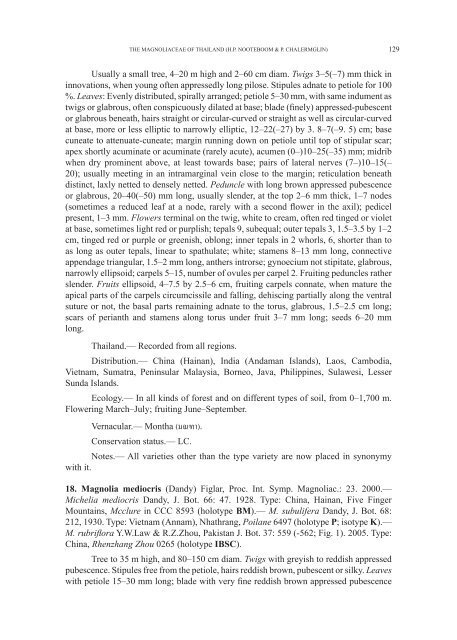Create successful ePaper yourself
Turn your PDF publications into a flip-book with our unique Google optimized e-Paper software.
THE MAGNOLIACEAE OF <strong>THAI</strong>LAND (H.P. NOOTEBOOM & P. CHALERMGLIN)<br />
Usually a small tree, 4–20 m high and 2–60 cm diam. Twigs 3–5(–7) mm thick in<br />
innovations, when young often appressedly long pilose. Stipules adnate to petiole for 100<br />
%. Leaves: Evenly distributed, spirally arranged; petiole 5–30 mm, with same indument as<br />
twigs or glabrous, often conspicuously dilated at base; blade (finely) appressed-pubescent<br />
or glabrous beneath, hairs straight or circular-curved or straight as well as circular-curved<br />
at base, more or less elliptic to narrowly elliptic, 12–22(–27) by 3. 8–7(–9. 5) cm; base<br />
cuneate to attenuate-cuneate; margin running down on petiole until top of stipular scar;<br />
apex shortly acuminate or acuminate (rarely acute), acumen (0–)10–25(–35) mm; midrib<br />
when dry prominent above, at least towards base; pairs of lateral nerves (7–)10–15(–<br />
20); usually meeting in an intramarginal vein close to the margin; reticulation beneath<br />
distinct, laxly netted to densely netted. Peduncle with long brown appressed pubescence<br />
or glabrous, 20–40(–50) mm long, usually slender, at the top 2–6 mm thick, 1–7 nodes<br />
(sometimes a reduced leaf at a node, rarely with a second flower in the axil); pedicel<br />
present, 1–3 mm. Flowers terminal on the twig, white to cream, often red tinged or violet<br />
at base, sometimes light red or purplish; tepals 9, subequal; outer tepals 3, 1.5–3.5 by 1–2<br />
cm, tinged red or purple or greenish, oblong; inner tepals in 2 whorls, 6, shorter than to<br />
as long as outer tepals, linear to spathulate; white; stamens 8–13 mm long, connective<br />
appendage triangular, 1.5–2 mm long, anthers introrse; gynoecium not stipitate, glabrous,<br />
narrowly ellipsoid; carpels 5–15, number of ovules per carpel 2. Fruiting peduncles rather<br />
slender. Fruits ellipsoid, 4–7.5 by 2.5–6 cm, fruiting carpels connate, when mature the<br />
apical parts of the carpels circumcissile and falling, dehiscing partially along the ventral<br />
suture or not, the basal parts remaining adnate to the torus, glabrous, 1.5–2.5 cm long;<br />
scars of perianth and stamens along torus under fruit 3–7 mm long; seeds 6–20 mm<br />
long.<br />
Thailand.— Recorded from all regions.<br />
Distribution.— China (Hainan), India (Andaman Islands), Laos, Cambodia,<br />
Vietnam, Sumatra, Peninsular Malaysia, Borneo, Java, Philippines, Sulawesi, Lesser<br />
Sunda Islands.<br />
Ecology.— In all kinds of forest and on different types of soil, from 0–1,700 m.<br />
Flowering March–July; fruiting June–September.<br />
Vernacular.— Montha (มณฑา).<br />
Conservation status.— LC.<br />
Notes.— All varieties other than the type variety are now placed in synonymy<br />
with it.<br />
18. Magnolia mediocris (Dandy) Figlar, Proc. Int. Symp. Magnoliac.: 23. 2000.—<br />
Michelia mediocris Dandy, J. Bot. 66: 47. 1928. Type: China, Hainan, Five Finger<br />
Mountains, Mcclure in CCC 8593 (holotype BM).— M. subulifera Dandy, J. Bot. 68:<br />
212, 1930. Type: Vietnam (Annam), Nhathrang, Poilane 6497 (holotype P; isotype K).—<br />
M. rubriflora Y.W.Law & R.Z.Zhou, Pakistan J. Bot. 37: 559 (-562; Fig. 1). 2005. Type:<br />
China, Rhenzhang Zhou 0265 (holotype iBsC).<br />
Tree to 35 m high, and 80–150 cm diam. Twigs with greyish to reddish appressed<br />
pubescence. Stipules free from the petiole, hairs reddish brown, pubescent or silky. Leaves<br />
with petiole 15–30 mm long; blade with very fine reddish brown appressed pubescence<br />
129
















